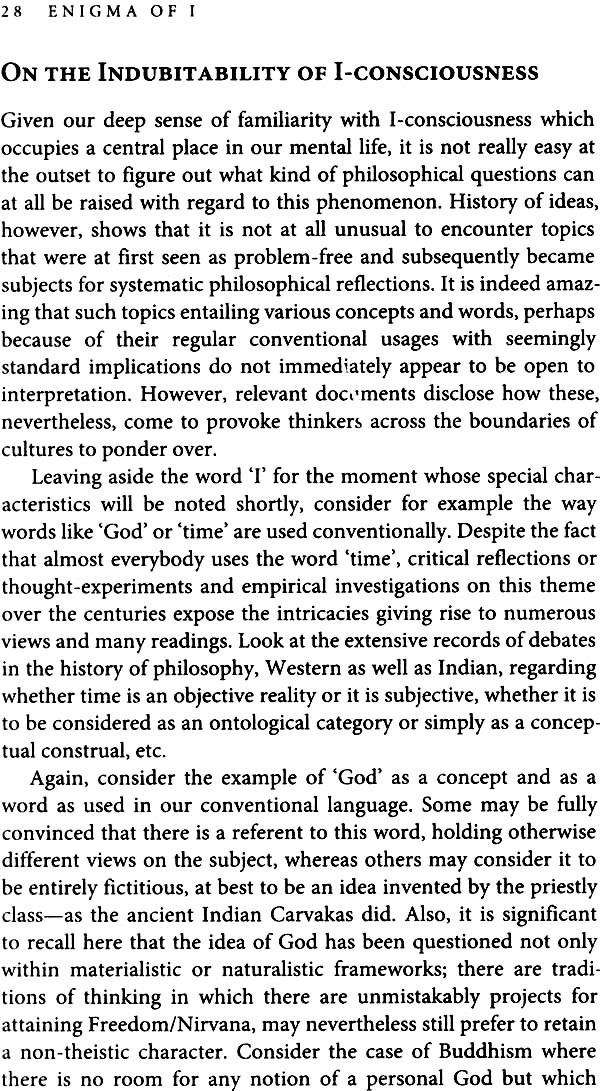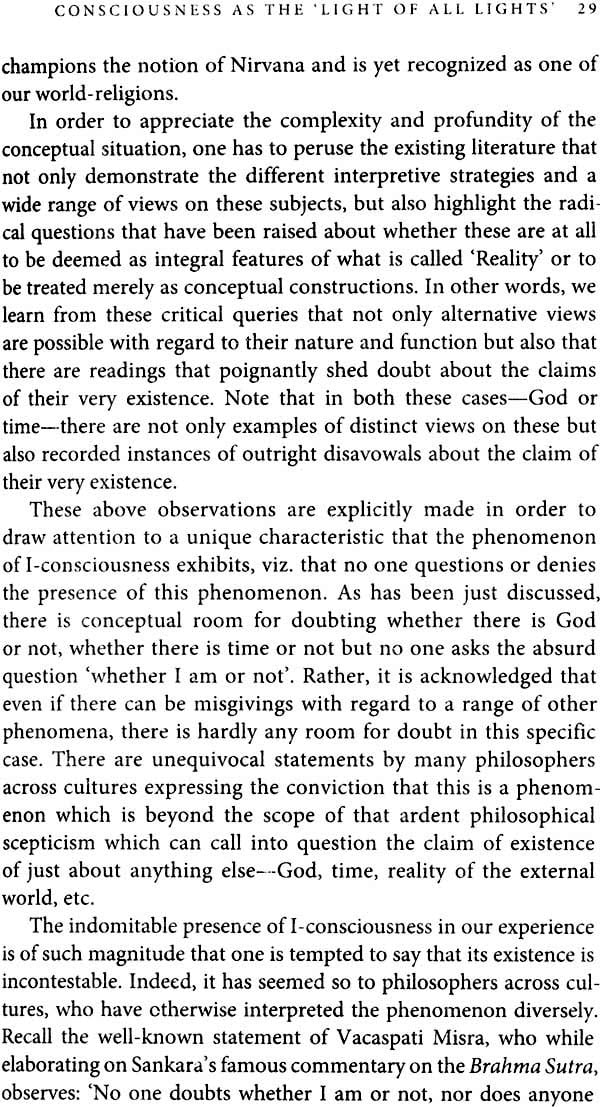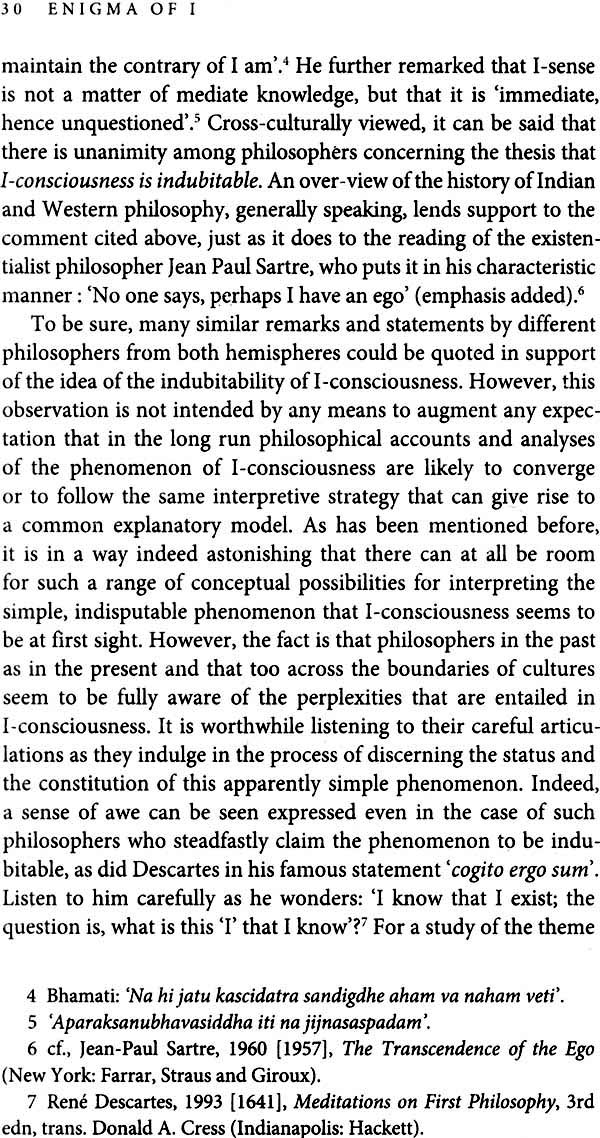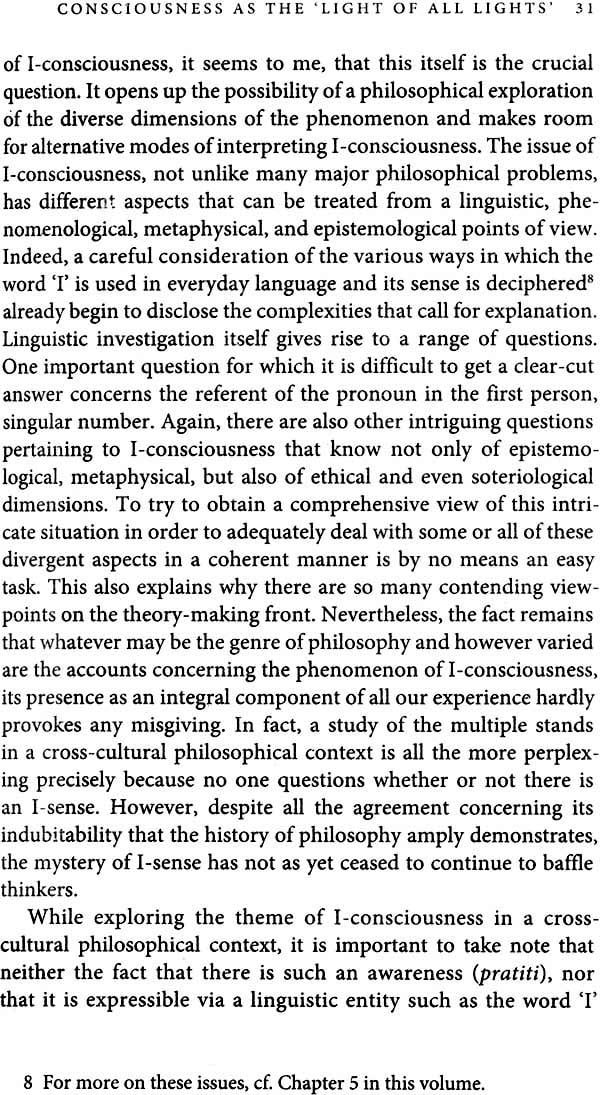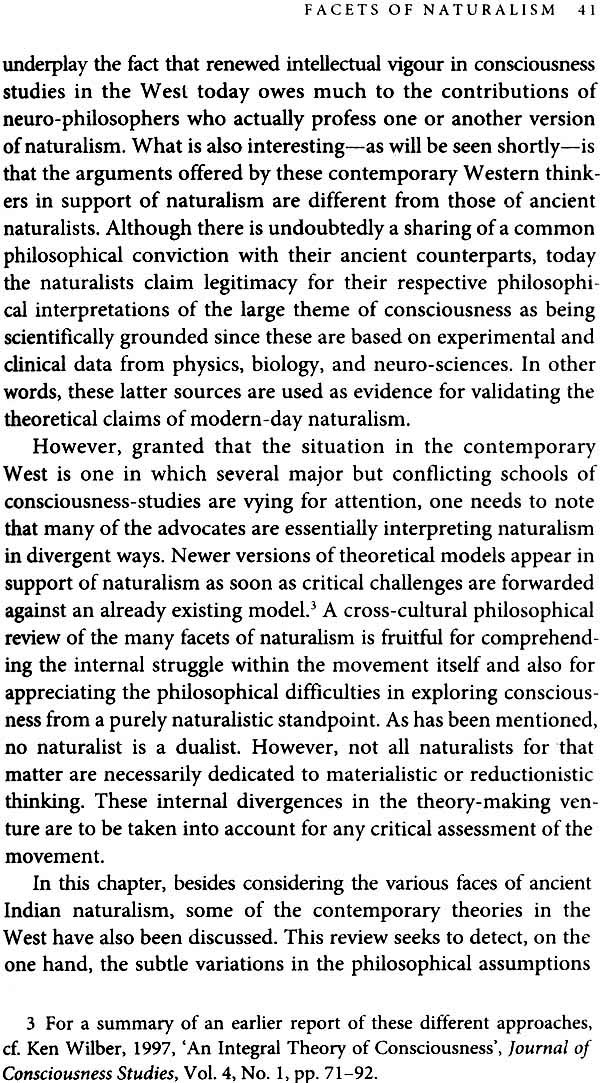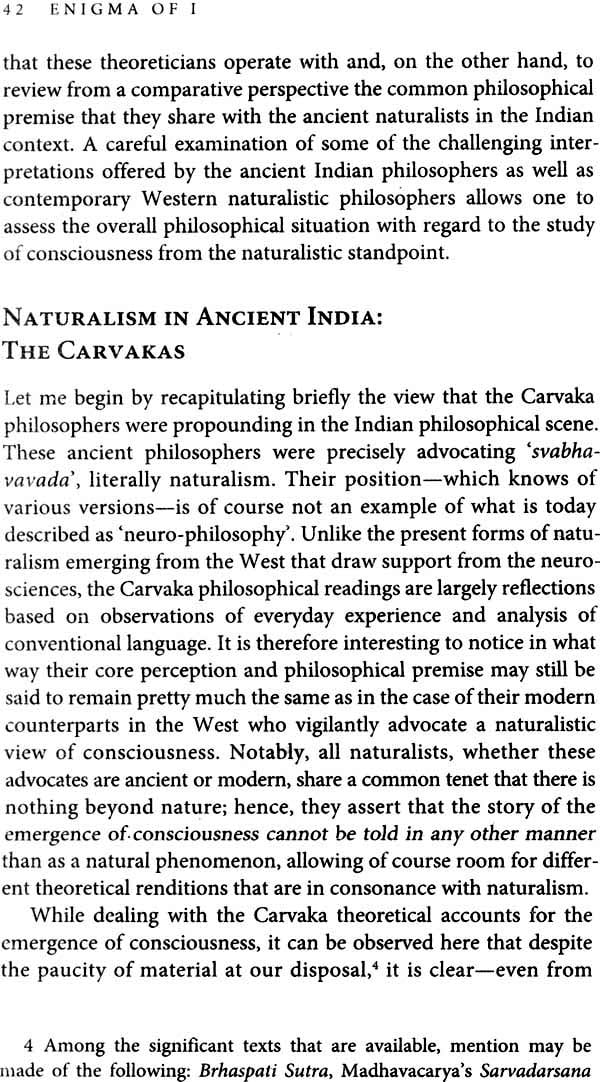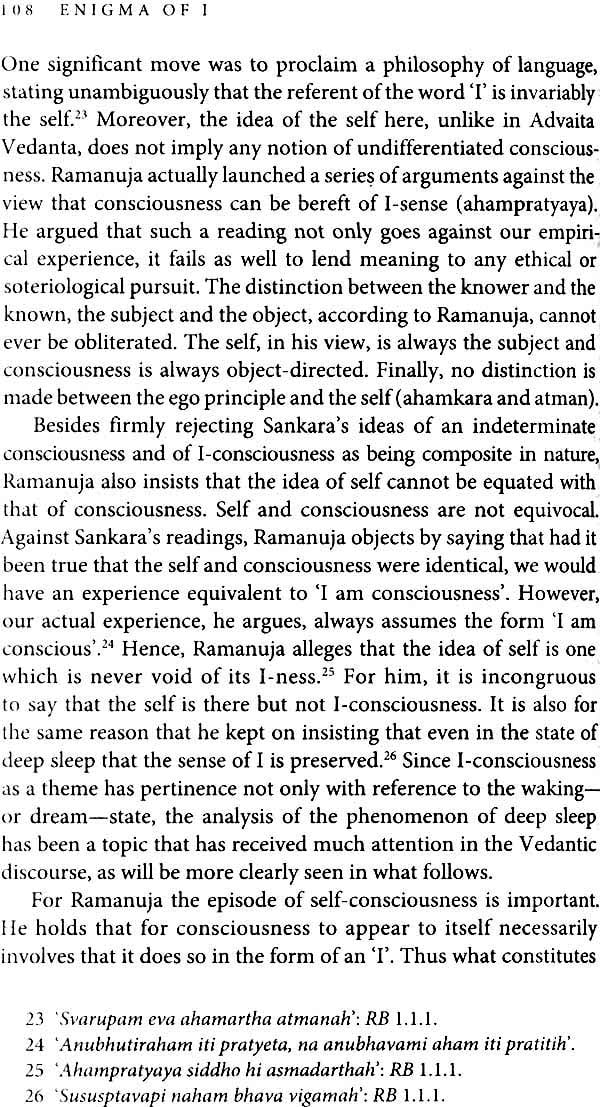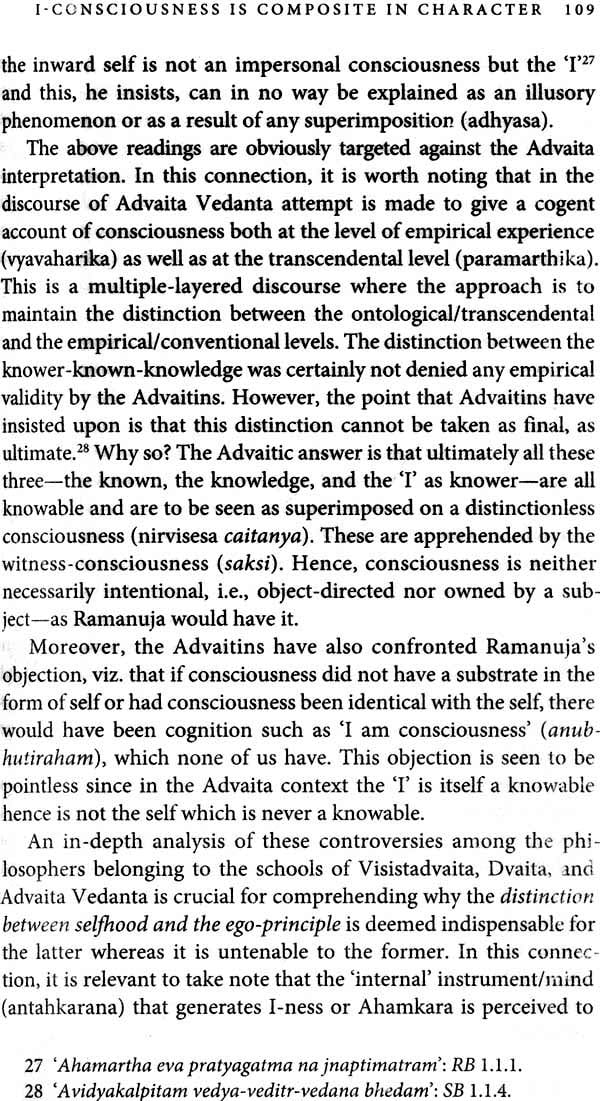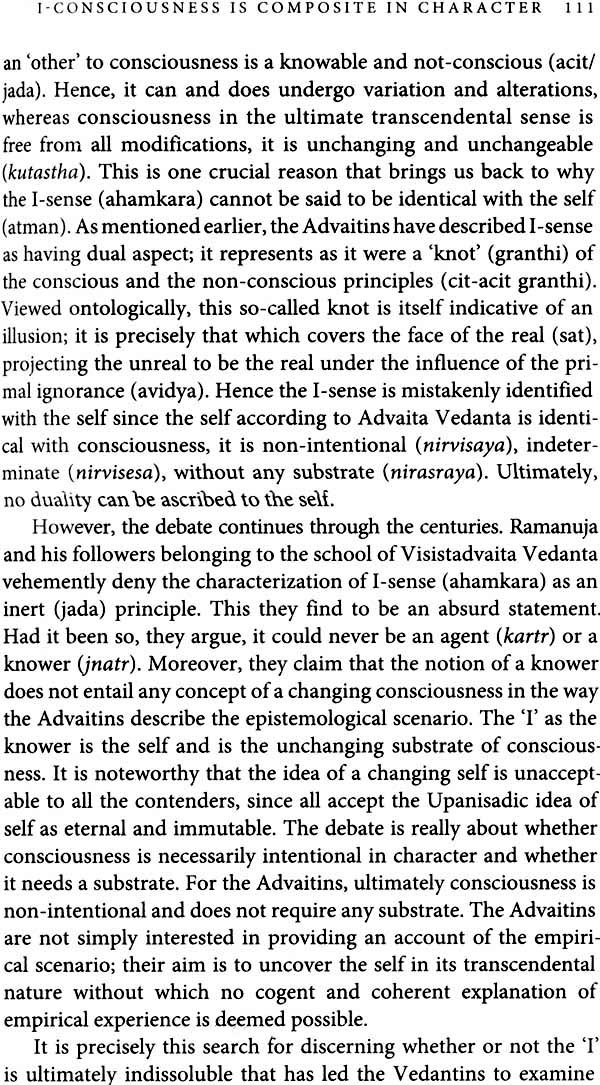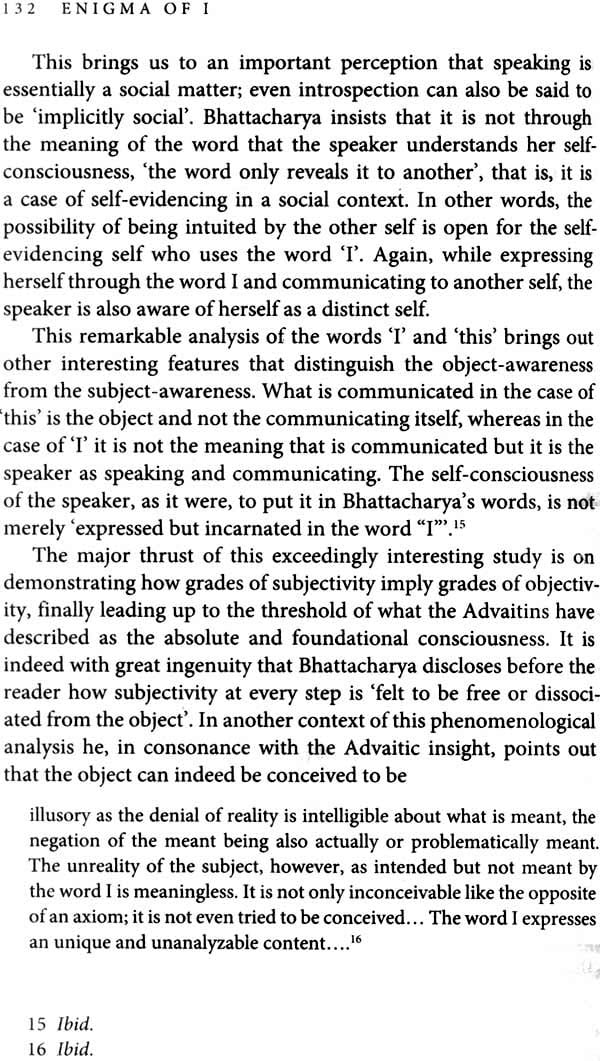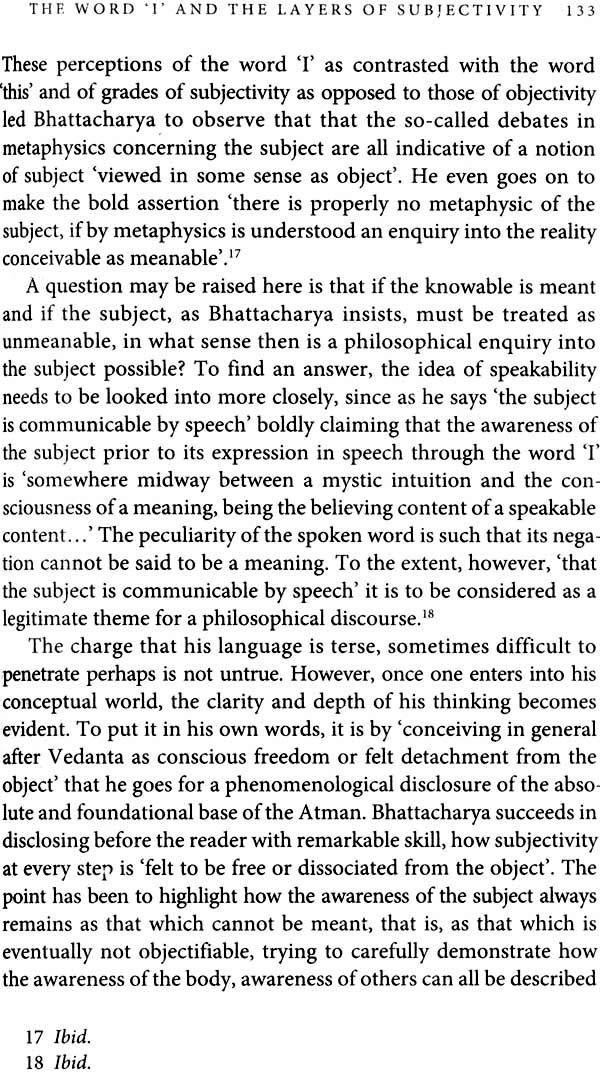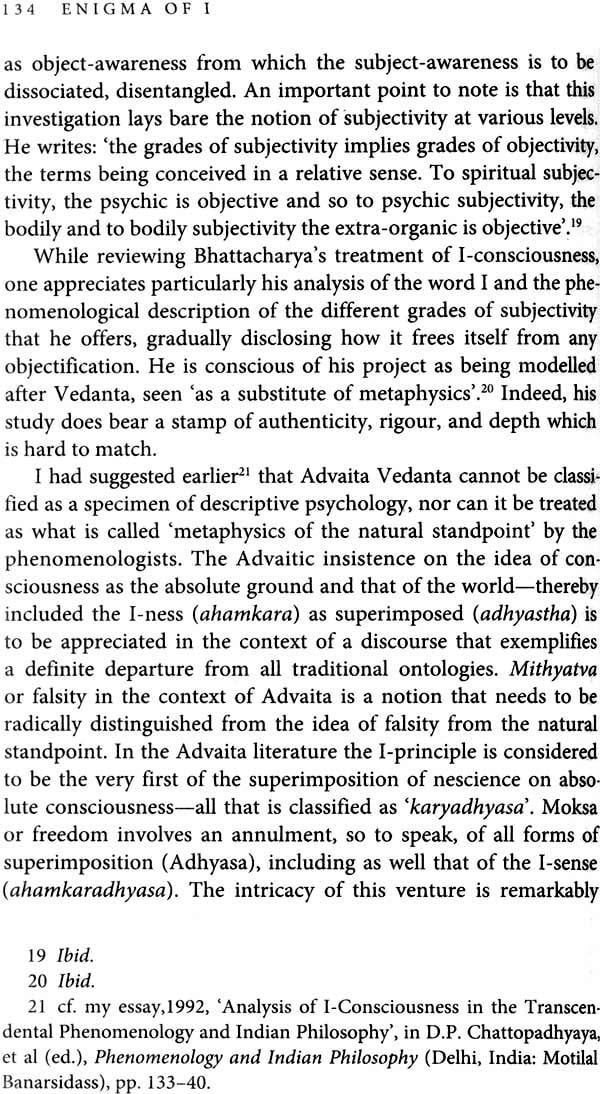
Aham: I (The Enigma of I - Consciousness)
Book Specification
| Item Code: | NAL069 |
| Author: | Anindita Niyogi Balslev |
| Publisher: | Oxford University Press, New Delhi |
| Language: | English |
| Edition: | 2013 |
| ISBN: | 9780198089513 |
| Pages: | 256 |
| Cover: | Hardcover |
| Other Details | 8.5 inch X 5.5 inch |
| Weight | 400 gm |
Book Description
The indubitability of I-consciousness is shared across cultures. It pervades our states of sleep, dream, and wakefulness that encompass what each of us calls ‘my life’-distinct from the lives of others. This book explores the different facets of the many philosophical adventures that have engaged with its enigmatic character.
Balslev examines the notions of I-consciousness in the different strands in Indian and Western philosophical thought, bringing them within a common conceptual framework. This cross-cultural study, traversing a variety of dimensions, addresses the paradox of performance and mutability of life and lays bare the subjectivity of its various interpretations.
An ambitious endeavour spanning a variety of thought, this book will be of interest to scholars, students, and researchers of Indian and Western philosophy.
Anindita Niyogi Balslev is a philosopher and the initiator of the forum ‘Cross-Cultural Conversation’ (CCC). She graduated from the University of Calcutta and received her doctorate from the University of Paris. Her educational, research, and teaching experience span over India, France, Denmark, and USA. She has published widely in the areas of Indian and Western thought, culture, and religion. She has organized several important international CCC conferences focusing on concerns relevant for meeting of cultures and encounter of world religions. She has published widely in the areas of Indian and Western thought, culture, and religion. Apart from numerous articles in professional journals, her publications include A Study of Time in Indian Philosophy, Cultural Otherness: Correspondence with Richard Rorty, Indian conceptual World, and the edited volumes, Cross Cultural Conversation, Toward Greater Human Solidarity, and On India: Self-image and Counter-image. She is also the co-editor of the volumes, Compassion in the World’d Religions and Religion and Time.
It was rather early in life, indeed long before any formal initiation as a student of philosophy, that I began wondering about the enigmatic character of I-consciousness. It is evidently indubitable, yet remains unfathomable. This is indeed a phenomenon that appears to resist all explanation but does not cease to challenge our understanding. What seemed then, as it also does now, to be especially intriguing is the remarkable manner in which this phenomenon sustains its identity in the midst of all kinds of change. It seems inevitable that any serious attempt to unravel I-consciousness is bound to assume in the long run the character of a quest that demands a readiness to walk on a ‘razor’s edge’, as our ancients put it.
Subsequently, as I delved into the history of philosophy, both Indian and Western, it became clear that none of the contending schools of thought provided a definitive answer that is acceptable to all. Nevertheless, these attempts unmistakably show that a search in this direction has led the enquirers to devise a range of explanatory models that are of deep philosophical interest. Moreover, accounts of this intricate process of second-order reflection disclose to an enquirer the important differences between the phenomenon of I-consciousness and any other topic- however profound, complex, or abstract- that has been subjected to philosophical scrutiny. Perhaps this difference lies in the particular way the presence of I-consciousness manifests itself. In contrast to any other mental episode where that which is apprehended has the status of not-I, the ‘I’ has the character of a subject and is never immediately encountered as an ‘other’ to or as an ‘object’ of consciousness- even if in some rare philosophical analysis it has been thus interpreted. This is also why an attempt to delineate I-consciousness invariably seems to demand much more than a purely cognitive probe in a discursive mode. In other words, if this is a phenomenon that simply cannot be formulated as a problem like any other phenomenon or subjected to similar sort of objective critical examination, it is precisely because of its very intimate and subjective character whose source and support remain beyond our cognitive grasp. We gaze at it with a sense of bewilderment, indeed, as the ‘puzzle of all puzzles’.
It is worth mentioning here that in the course of my reflections I was simply struck by the gradual unfolding of the multiple layers of subjectivity. The phenomenon of I-consciousness is not only absolutely central to all our cogitations on cognitions, emotions, and volitions, but is also invariably impregnated with deep existential concerns that have subtle moral as well as soteriological dimensions. Remaining rooted in the very centre of our existence, this phenomenon is inextricably intertwined with the recurring states of sleep, dream, and wakefulness that encompass what each of us calls ‘my life’, demarcating it as distinct from the lives of others. To put it more poignantly, if I-consciousness, on the one hand, seems to be inseparably linked to our cherished sense of being here and now, on the other hand, it can hardly be disentangled from the weird sense of uncertainty arising from not knowing how it manifests itself .To make matters even worse, there is a feeling of dead-certainty that this ‘I’ is not here to stay, at least not in its present base. However, in all cases this awareness of ‘I’ involves a physical complex that I describe as ‘my body’, since along with I-consciousness there is always an entailed a feeling of intimacy with ‘my body’, where the line between a sense of identity and that of difference is blurred but not fully missing. Later on, during my studies, I was to gradually encounter a host of theories interpreting the dawning of ‘the sense of self’ in relation to this intimate yet ambivalent ‘body-awareness’, giving rise to such competing theatrical claims, as dualism and monism. Each of these positions comes in several versions within which in turn there are subtle internal divergences. The former philosophical stance clearly acknowledges the reality of both, leading to what has been designated as the ‘mind-body problem’. The latter may assume the form of one of the several versions of physicalism, or the other extreme of affirming the sole ontological reality of consciousness, accounting for the first person in each case variously. Indeed, there are various designations that bear witness to the intricacies that theory-makers introduce while weaving theories about the status of I-consciousness- a phenomenon that otherwise no one doubts or denies.
It is not surprising to find that this topic of I-consciousness has called for an intellectual exploration of an incredibly wide range of interconnected issues in the historical context of cross cultural philosophical enquiries. There are ample records that testify to diverse theoretical interpretations of I-consciousness along with a large number of questions and concerns which touch upon this central theme of human existence, ranging from birth to death. As is to be expected, these questions have psychological, epistemological, metaphysical, ethical, and even religious dimensions. Viewed holistically, all these concerns are significant parts of such an investigation. However, given the existing disciplinary boundaries in academia at present, the focus is on specific aspects of this theme in particular disciplines. A comprehensive undertaking calls for collaborative work, which is still missing. Nevertheless, one comes across imaginative speculations that have ensued from various quarters in the course of exploration of what lies at the core of I-consciousness.
There are narratives-philosophical, religious, and mythological- which describe the phenomenon either in a similar or in an opposed fashion. Some, for example, speak of its ultimate imperishable character and others, on the contrary, of its inevitable dissolution and eventual passing into nothingness. A variety of stories and accounts exist concerning the emergence of this phenomenon, in terms of its creation, its embodiment, or its embrainment. In some of those that are available from cross-cultural sources, the I-consciousness of the present life is depicted as unique, whereas others maintain the possibility of its continuation through many lives, often situating the accounts within specific soteriological frameworks. Indeed, the diverse renditions of these views that are naturally at variance depend not only upon the genre of texts one is consulting- ancient or modern – but also on the convictions of the narrators themselves about the source of the sense of I. Reference will be made later on in this monograph to these debates that are not merely of historical interest but are relevant even today with regard to such issues as whether the phenomenon can be said to arise and to exist exclusively within or only in close association with the physical and the neuro-biological processes, or whether its source must be sought elsewhere. In other words, just as there are some who claim that the first person features are entirely embedded in physiological processes, there are others who reject such a theoretical rendition, holding the view instead that this phenomenon is an expression of an irreducible, non-physical principle. Consequently, documents also disclose a host of speculations concerning the status of the first person in the context of death and hereafter. According to some, the sense of ‘I’ is eventually destined to dissolve into nothingness at death. Again, there are others who claim that death is nothing but a casting off of the mortal frame, that is, the physical garb with which the sense of self is provisionally associated at present. There are many reordered statements about the possibilities of pre-natal as well as post-mortem existence. All cultures are storehouses of such stories.
In philosophical literature ‘I-consciousness’ is a accounted for with or without reference to a metaphysical entity called the self or atman. Mythologically, the self is often treated as the emblem of immortality. Many thinkers across cultures are even persuaded to ponder over, among various other concerns, the soteriological significance of the phenomenon. Consequently, advocates of some traditions not only pronounce that a notion of a metaphysical self is to be assumed in order to explain I-consciousness, they even boldly declare that ‘knowledge of the self’ is the same as salvatory or liberating knowledge. However, it is remarkable that even among philosophers of such persuasions there are widespread controversies regarding the very idea of self. A survey of the Upanisadic tradition provides us with classical examples of how, despite the common tenet of the ontological reality of atman, many subtle differences nevertheless arise in the elaboration of the notion of self in their rich variety are discussed in this monograph.
A search for the source of I-consciousness
This study aims at creating an appreciation for the many facets of the question of I-consciousness, primary focusing on Indian sources, but also referring to Western philosophy. Cross-cultural conceptual resources can indeed inform us about the divergent perspectives and the philosophical intricacies with regard to this fascinating theme. A philosophical probe into this phenomenon opens up a very complex area of investigation where notions of change and permanence, identity and difference remain locked in a perplexing manner. Indeed, attempts to unveil I-consciousness have incited diverse methods of enquiry, leading to different conceptual approaches. Even a cursory glance at a global history of ideas pertaining to this theme amply demonstrates that these inquiries have proceeded on the basis of varied assumptions; consequently, the enquirers have often reached dissimilar conclusions. Remarkably diverse conceptual hues are visible in the records of speculations covering an array of interpretive strategies that range from firmly naturalistic stances to those that are almost on the verge of the esoteric. The general feeling, nevertheless, is that none of the theoretical moves has the kind of explanatory power that is needed in order to provide a completely coherent picture to the satisfaction of all enquirers coming from diverse disciplinary and cultural backgrounds. Perhaps, it is only when we hear the stories that are woven around this fundamental theme, told in different tongues and in different voices, that we will be able to adequately situate the queries within a common frame of enquiry and take stock of the pertinent issues concerning I-consciousness. We can then appreciate the arguments and motivations that prompt critical thinking within various intellectual traditions on this topic and understand why despite the common existential core the theoretical narratives deviate.
To start with, I-consciousness seems to form a stable nucleus of our incessantly changing mental life. However, reflection lays bare the intricacies that are inherent in the theme intertwined with a broad spectrum of concerns. Following the customary academic disciplinary labelling practices, these are often discerned and categorized as epistemological, linguistic, psychological, ethical, metaphysical, and religious concerns. A few representative samples from Indian and Western philosophical sources that will be discussed in what follows demonstrate the form and content of such analyses.
What is remarkable is that although the presence of I-consciousness is commonly acknowledged as being of central importance, the phenomenon itself seems to remain inscrutable defying any close examination. What makes I-consciousness especially difficult to unveil is the fact that it is never encountered in our experience in an isolated fashion. In other words, we simply cannot capture in abstraction the ‘I-phenomenon’ all by itself for a philosophical inspection. No matter how carefully one proceeds to examine by going deep into the inner recesses of experience in order to grasp the ‘I’ as a solitary phenomenon in its transparency, it resists disclosure. It remains constantly and continuously intermingled with some other component, which is other than the ‘I’. This becomes clear as one attempts to withdraw from everything else in order to clasp it existentially or seeks for the exact referent or even for a sense of what is linguistically expressed by the pronoun in first person singular number. It can hardly be entirely disentangled from the not-I. This feature has been observed by certain philosophers both in India and in the West.
Consequently, we find that some philosophers highlight an unshakeable conviction about the irreducibility of I-consciousness. They are prone to consider, as their analyses show, an identical, abiding ‘selfhood’ as its basis, and attribute to the phenomenon a set of metaphysical characteristics. On the other hand, there are philosophers who outright question its seeming unity, its homogeneity, and make those characterizations that are favoured by the advocates of the former camp look dubious. Moreover, what is especially worth noticing is that none of these contending paradigmatic models-that is, those that generally operate with the idea of self as well as those which do not- come in just one standardized, uniform formulation. In other words, striking internal differences abound in both camps while their respective proponents project and justify their own interpretations. Thus, as relevant literature discloses, a firm affirmation of the idea of the indubitable presence of a self as the basis of I-consciousness can go hand in hand with different notions about the self. Likewise, one also encounters varied lines of interpretation from those quarters where the thinkers altogether deny the former position, advocating instead the view that there can be found no abiding self at all. In other words, there are alternative versions of both paradigms. The point worth noting is, in short, that although the sense of indispensability and indubitability of I-consciousness has not been seriously questioned by philosophers in general, this does not entail that the idea of an ‘abiding self’ has been unanimously accepted as a necessary implication of that universal experience (sarvanubhava-siddha) of I-consciousness. On the other hand, literary records show that there is a variety of interpretations- both from secular and religious standpoints- where the no-self position has been defended while accounting for the phenomenon of I-consciousness. Reference will be made to such views later on in this work. Interestingly, there are also some theoreticians who even claim the ‘I’ to be no more than a conventional, socially constituted linguistic entity.
Thus, while focusing on the central theme of I-consciousness, one comes across an entire gamut of metaphysical views concerning what the ‘first person’ is all about. This is a quest which has been present from time immemorial in religious discourses. Moreover, various mythologies across cultures seem to have been equally probing to find an answer. Currently, scientific research in the domain of neuro-physiology and brain-research has provided a rich resource for further investigation in this direction. Philosophical renditions based on these neuro-physiological studies are now part of the global history of ideas and surely many more theories about consciousness are in the process of construal at present. The available material is indeed vast, especially in a cross-cultural philosophical setting. Precisely this wide canvas is needed as that alone enables an investigator to appreciate the subtle challenges that confront the theoreticians and lead them to hold contending views about I-consciousness. One of the goals of this study has been to draw attention to some of these varied readings from different sources and exemplify in the process how answers to the same or similar questions can sometimes converge and at other times be at variance with one another. To be sure, a project of this sort also demonstrates that not all questions are necessarily asked everywhere, at least not with the same rigor and emphasis. Interpretive strategies differ while engaging in the common cognitive pursuit regarding the theme of I-consciousness, since specific investigators have diverse points of departure. Moreover, the conceptual gaps between the philosophical awareness of the theoretical bearing of a first person account of subjectivity and of the limitation of a third person account of the ‘I’ are also striking. An overall review of such a seemingly simple phenomenon calls for a cautious study not only of various expository material but also of the recorded debates and controversies centring on a variety of crucial issues related to the theme of I-consciousness. A close inspection of the relevant literature concerning the question of subjectivity discloses, as mentioned before, various dimensions of this investigation and brings out the psychological, epistemological, metaphysical, linguistic, ethical, and even religious implications of a given stand. This monograph focuses on some of the fundamental issues and questions that keep reappearing in a cross-cultural philosophical sontext, while drawing from some select works by a few distinguished philosophers representing different thought-traditions.
Given the indubitability of I-consciousness, the philosophical search has been to detect its source. It is noteworthy in this connection that although in the history of Indian and Western thought one comes across diverse conceptual moves that are employed for studying the theme of I-consciousness, the predominant paradigms nevertheless seem by and large to be based on two distinctly different moulds of explanation. These primary lines of interpretation are formulated either by affirming or by negating the notion of an identical self. Indeed, these philosophical views are often informed by religious concerns and scientific findings. The main concern of this study is to highlight some of the predominant views of philosophers from the Indian sources belonging to the Upanisadic as well as the Buddhist traditions. These views will be discussed especially with reference to carefully selected expository as well as polemical material that has profound bearing on the central concern of this monograph. To mention some Western philosophers whose significant contributions will be referred to are Descartes, Locke, Hume, Kant, Husserl, and Sartre as well as contemporary scholars such as Strawson, Parfit, Nozick, and a host of naturalistic thinkers like Nagel, Curchland, Searle, etc. Although Hegel, Freud, Piaget, and Mead are known for their respective contributions toward exposing various aspects of this complex theme, reference to their concerns calls for a wider framework than that of this monograph. In the section below, a brief account is attempted as a way of introducing the reader to the nature of the speculation in the early Upanisadic tradition that preceded the emergence of specific schools of philosophy.
| Preface | ix | |
| Introduction | 1 | |
| 1 | Consciousness as the 'Light of all Lights' | 22 |
| 2 | Facets of Naturalism | 38 |
| 3 | Self as Substance: The Basis of I-consciousness | 63 |
| 4 | I-consciousness as Composite: Divergent Views within the Upanisadic Tradition | 88 |
| 5 | On the Meaning of the Word 'I' and the Layers of Subjectivity | 123 |
| 6 | I and the No-self Theories: Differences within the Buddhist Tradition | 145 |
| 7 | Some Conceptual Scenarios in Cross-cultural Context | 174 |
| Epilogue | 199 | |
| Glossary | 211 | |
| Select Bibliography | 221 | |
| Index | 227 | |
| About the Author | 233 |
